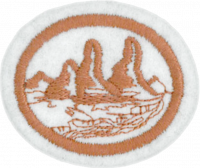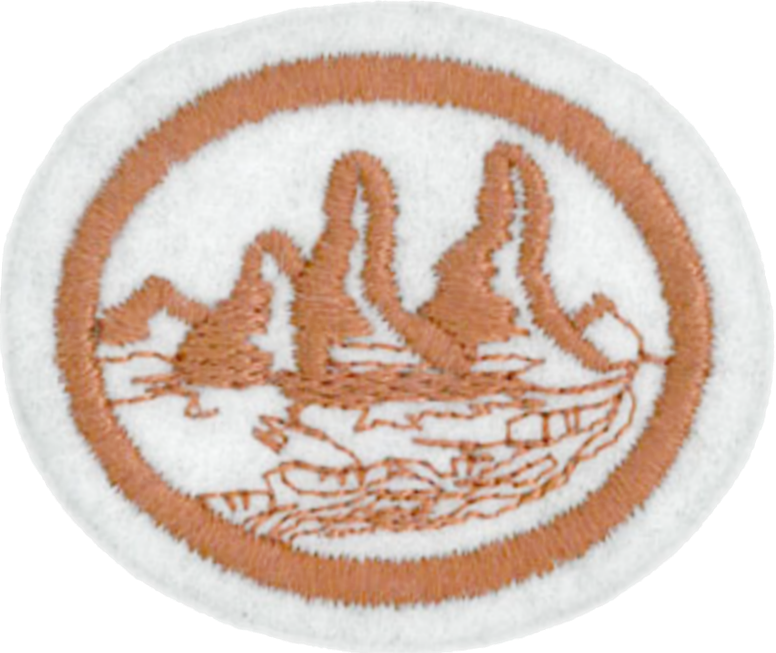Difference between revisions of "AY Honors/Geology/Requirements"
From Pathfinder Wiki
Jomegat bot (talk | contribs) m (Add RequirementsHeader) |
m |
||
| (11 intermediate revisions by 3 users not shown) | |||
| Line 1: | Line 1: | ||
| − | + | {{HonorSubpage}} | |
| + | |||
| + | <section begin=Body /> | ||
| + | |||
| + | <b>1. <section begin=req1 /><noinclude><translate><!--T:1--> | ||
| + | </noinclude>Give the geological meaning of the following words: | ||
| + | <noinclude></translate></noinclude><section end=req1 /></b> | ||
| + | |||
| + | :<b>a. <section begin=req1a /><noinclude><translate><!--T:2--> | ||
| + | </noinclude>Delta | ||
| + | <noinclude></translate></noinclude><section end=req1a /></b> | ||
| + | |||
| + | :<b>b. <section begin=req1b /><noinclude><translate><!--T:3--> | ||
| + | </noinclude>Sand spit | ||
| + | <noinclude></translate></noinclude><section end=req1b /></b> | ||
| + | |||
| + | :<b>c. <section begin=req1c /><noinclude><translate><!--T:4--> | ||
| + | </noinclude>Sinkhole | ||
| + | <noinclude></translate></noinclude><section end=req1c /></b> | ||
| + | |||
| + | :<b>d. <section begin=req1d /><noinclude><translate><!--T:5--> | ||
| + | </noinclude>Oxbow lake | ||
| + | <noinclude></translate></noinclude><section end=req1d /></b> | ||
| + | |||
| + | :<b>e. <section begin=req1e /><noinclude><translate><!--T:6--> | ||
| + | </noinclude>Moraine | ||
| + | <noinclude></translate></noinclude><section end=req1e /></b> | ||
| + | |||
| + | :<b>f. <section begin=req1f /><noinclude><translate><!--T:7--> | ||
| + | </noinclude>Cirque | ||
| + | <noinclude></translate></noinclude><section end=req1f /></b> | ||
| + | |||
| + | :<b>g. <section begin=req1g /><noinclude><translate><!--T:8--> | ||
| + | </noinclude>Mesa | ||
| + | <noinclude></translate></noinclude><section end=req1g /></b> | ||
| + | |||
| + | :<b>h. <section begin=req1h /><noinclude><translate><!--T:9--> | ||
| + | </noinclude>Alluvial fan | ||
| + | <noinclude></translate></noinclude><section end=req1h /></b> | ||
| + | |||
| + | :<b>i. <section begin=req1i /><noinclude><translate><!--T:10--> | ||
| + | </noinclude>Anticline | ||
| + | <noinclude></translate></noinclude><section end=req1i /></b> | ||
| + | |||
| + | :<b>j. <section begin=req1j /><noinclude><translate><!--T:11--> | ||
| + | </noinclude>Syncline | ||
| + | <noinclude></translate></noinclude><section end=req1j /></b> | ||
| + | |||
| + | <b>2. <section begin=req2 /><noinclude><translate><!--T:12--> | ||
| + | </noinclude>Describe the following: | ||
| + | <noinclude></translate></noinclude><section end=req2 /></b> | ||
| + | |||
| + | :<b>a. <section begin=req2a /><noinclude><translate><!--T:13--> | ||
| + | </noinclude>A shield-type volcano as compared to a composite volcano | ||
| + | <noinclude></translate></noinclude><section end=req2a /></b> | ||
| + | |||
| + | :<b>b. <section begin=req2b /><noinclude><translate><!--T:14--> | ||
| + | </noinclude>How a glacier moves and what evidences it leaves behind | ||
| + | <noinclude></translate></noinclude><section end=req2b /></b> | ||
| + | |||
| + | :<b>c. <section begin=req2c /><noinclude><translate><!--T:15--> | ||
| + | </noinclude>How sediments are laid down by water | ||
| + | <noinclude></translate></noinclude><section end=req2c /></b> | ||
| + | |||
| + | :<b>d. <section begin=req2d /><noinclude><translate><!--T:16--> | ||
| + | </noinclude>The different types of mountains | ||
| + | <noinclude></translate></noinclude><section end=req2d /></b> | ||
| + | |||
| + | :<b>e. <section begin=req2e /><noinclude><translate><!--T:17--> | ||
| + | </noinclude>Why a river or stream bank often keeps caving in on the outside of a bend | ||
| + | <noinclude></translate></noinclude><section end=req2e /></b> | ||
| + | |||
| + | <b>3. <section begin=req3 /><noinclude><translate><!--T:18--> | ||
| + | </noinclude>Know what category of rocks (sedimentary, metamorphic, or igneous) the following rocks are: | ||
| + | <noinclude></translate></noinclude><section end=req3 /></b> | ||
| + | |||
| + | :<b>a. <section begin=req3a /><noinclude><translate><!--T:19--> | ||
| + | </noinclude>Granite | ||
| + | <noinclude></translate></noinclude><section end=req3a /></b> | ||
| + | |||
| + | :<b>b. <section begin=req3b /><noinclude><translate><!--T:20--> | ||
| + | </noinclude>Sandstone | ||
| + | <noinclude></translate></noinclude><section end=req3b /></b> | ||
| + | |||
| + | :<b>c. <section begin=req3c /><noinclude><translate><!--T:21--> | ||
| + | </noinclude>Conglomerate | ||
| + | <noinclude></translate></noinclude><section end=req3c /></b> | ||
| + | |||
| + | :<b>d. <section begin=req3d /><noinclude><translate><!--T:22--> | ||
| + | </noinclude>Slate | ||
| + | <noinclude></translate></noinclude><section end=req3d /></b> | ||
| + | |||
| + | :<b>e. <section begin=req3e /><noinclude><translate><!--T:23--> | ||
| + | </noinclude>Shale | ||
| + | <noinclude></translate></noinclude><section end=req3e /></b> | ||
| + | |||
| + | :<b>f. <section begin=req3f /><noinclude><translate><!--T:24--> | ||
| + | </noinclude>Marble | ||
| + | <noinclude></translate></noinclude><section end=req3f /></b> | ||
| + | |||
| + | :<b>g. <section begin=req3g /><noinclude><translate><!--T:25--> | ||
| + | </noinclude>Lava | ||
| + | <noinclude></translate></noinclude><section end=req3g /></b> | ||
| + | |||
| + | :<b>h. <section begin=req3h /><noinclude><translate><!--T:26--> | ||
| + | </noinclude>Limestone | ||
| + | <noinclude></translate></noinclude><section end=req3h /></b> | ||
| + | |||
| + | :<b>i. <section begin=req3i /><noinclude><translate><!--T:27--> | ||
| + | </noinclude>Basalt | ||
| + | <noinclude></translate></noinclude><section end=req3i /></b> | ||
| + | |||
| + | :<b>j. <section begin=req3j /><noinclude><translate><!--T:28--> | ||
| + | </noinclude>Gneiss | ||
| + | <noinclude></translate></noinclude><section end=req3j /></b> | ||
| + | |||
| + | <section begin=challenge /> | ||
| + | <b>4. <section begin=req4 /><noinclude><translate><!--T:29--> | ||
| + | </noinclude>Take a picture or make a sketch of each of the following geological features: | ||
| + | <noinclude></translate></noinclude><section end=req4 /></b> | ||
| + | |||
| + | :<b>a. <section begin=req4a /><noinclude><translate><!--T:30--> | ||
| + | </noinclude>A bed of sediment that is coarser at the bottom and finer toward the top (This is called normal graded bedding.) | ||
| + | <noinclude></translate></noinclude><section end=req4a /></b> | ||
| + | |||
| + | :<b>b. <section begin=req4b /><noinclude><translate><!--T:31--> | ||
| + | </noinclude>Ripple marks in sand or mud (Show with an arrow the current direction if possible.) | ||
| + | <noinclude></translate></noinclude><section end=req4b /></b> | ||
| + | |||
| + | :<b>c. <section begin=req4c /><noinclude><translate><!--T:32--> | ||
| + | </noinclude>Gully erosion | ||
| + | <noinclude></translate></noinclude><section end=req4c /></b> | ||
| + | |||
| + | :<b>d. <section begin=req4d /><noinclude><translate><!--T:33--> | ||
| + | </noinclude>Mud cracks (These can usually be found after a heavy rain or flood when mud starts to dry.) | ||
| + | <noinclude></translate></noinclude><section end=req4d /></b> | ||
| + | |||
| + | :<b>e. <section begin=req4e /><noinclude><translate><!--T:34--> | ||
| + | </noinclude>Soil profile along a stream bank or road cut (You should be able to see how soil usually becomes lighter colored downward from the surface of the ground.) | ||
| + | <noinclude></translate></noinclude><section end=req4e /></b> | ||
| + | |||
| + | :<b>f. <section begin=req4f /><noinclude><translate><!--T:35--> | ||
| + | </noinclude>Sand bar (Sand bars can be found in rivers or streams, or along the ocean.) | ||
| + | <noinclude></translate></noinclude><section end=req4f /></b> | ||
| + | <section end=challenge /> | ||
| + | <section end=Body /> | ||
Latest revision as of 01:40, 4 January 2023
1. Give the geological meaning of the following words:
- a. Delta
- b. Sand spit
- c. Sinkhole
- d. Oxbow lake
- e. Moraine
- f. Cirque
- g. Mesa
- h. Alluvial fan
- i. Anticline
- j. Syncline
2. Describe the following:
- a. A shield-type volcano as compared to a composite volcano
- b. How a glacier moves and what evidences it leaves behind
- c. How sediments are laid down by water
- d. The different types of mountains
- e. Why a river or stream bank often keeps caving in on the outside of a bend
3. Know what category of rocks (sedimentary, metamorphic, or igneous) the following rocks are:
- a. Granite
- b. Sandstone
- c. Conglomerate
- d. Slate
- e. Shale
- f. Marble
- g. Lava
- h. Limestone
- i. Basalt
- j. Gneiss
4. Take a picture or make a sketch of each of the following geological features:
- a. A bed of sediment that is coarser at the bottom and finer toward the top (This is called normal graded bedding.)
- b. Ripple marks in sand or mud (Show with an arrow the current direction if possible.)
- c. Gully erosion
- d. Mud cracks (These can usually be found after a heavy rain or flood when mud starts to dry.)
- e. Soil profile along a stream bank or road cut (You should be able to see how soil usually becomes lighter colored downward from the surface of the ground.)
- f. Sand bar (Sand bars can be found in rivers or streams, or along the ocean.)


